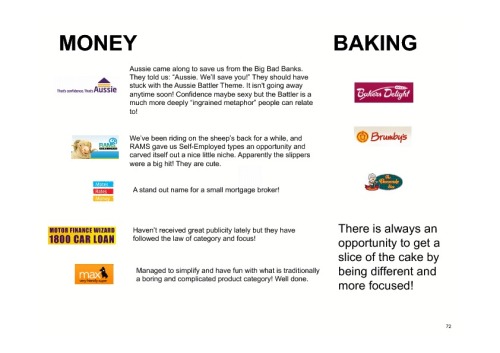
by admin | Feb 19, 2011 | Blog, Content, Design, Promotion, Strategy
A Brand Positioning Statement, also known as a slogan or a strap line, is the creative interpretation of the Brand Promise or USP which we discussed earlier.
Brand (Positioning Statements) should be able to hold their position in the long run and ideally achieve the following 4 criteria:
- Differentiate the business (Communicate the USP)
- Provide a Creative (Campaignable and Sustainable) platform
- Benefits should be ideally expressed explicitly to the customer
- Provide support to the brand name
Even when designing a brand from scratch it is difficult to satisfy all 4 criteria, so meeting 3 for a new brand or even 2 during a re-brand is often a great result.
You need to communicate with:
- Clarity
- Consistency
- Compression
to ‘cut through’ the clutter that is now prevalent in most service and product categories to consumers who are bombarded by more commercial messages than ever before!
So how do we do this?
Firstly we need to “own “own” a place in the consumer mind.
the easiest and most effective way of “owning a place in your customers’ and prospects’ minds is to focus on the things that matter. Most small and medium enterprises do not have the time or the money to be all things to all people, in fact neither do the very big companies, and when they try, they end up meaning nothing to anybody.
The result is at best mediocrity.
Focus demands Sacrifice – To own something you need to give up something else.
Focus on the particular type of buyer. Markets consist of buyers who differ in their:
- Wants
- Resources
- Locations
- Buying attitudes
- Buying behaviours
Simplicity adds value, by adding a halo effect for other benefits:
- Simple benefit (the most important promise) oriented word works best no matter how complex the product or market.
- The word must be exclusive.
- Avoid change, personalities don’t change, neither should your Brand.
- Positioning takes years and people don’t really change.
Next we will illustrate the power of brand positioning and focus with some examples.
How 2 Players Effectively communicated their Brand Positioning

Here are 2 industries and examples how the different players have through focus have found their niche and then effectively communicated their brand positioning.
Examples of the segmentation and brand positioning in the car…
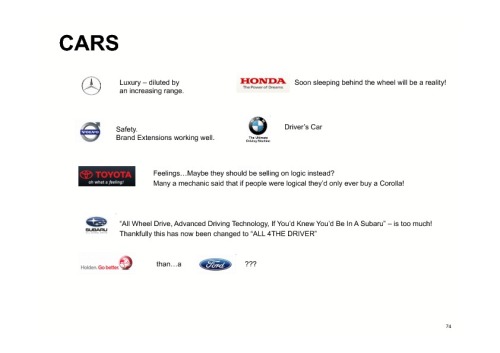
Examples of the segmentation and brand positioning in the car industry.
Positioning examples through segmentation in the car insurance…
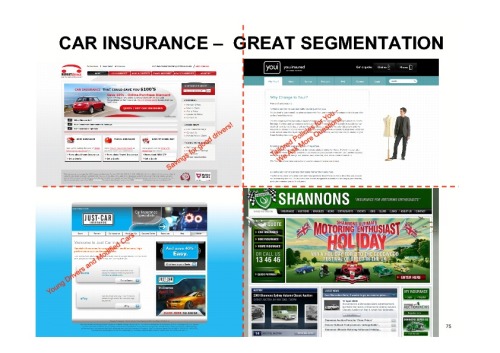
Positioning examples through segmentation in the car insurance category.
Most of the builders don’t have a positioning statement…
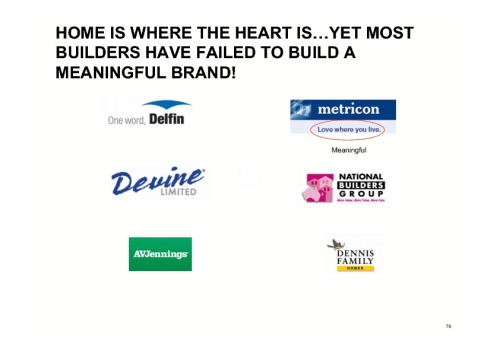
Most of the builders don’t have a positioning statement and are missing out on a great opportunity to truly connect with their prospects as well as be able to develop creative and more effective communication.
There is always an opportunity to be the “first”…
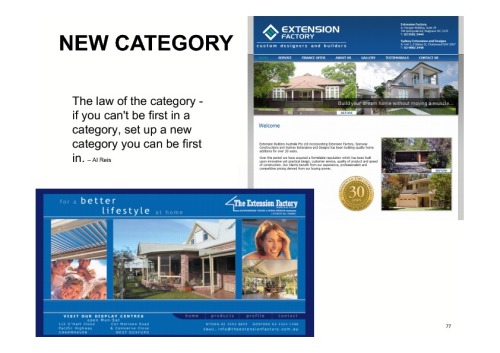
There is always an opportunity to be the “first” through even more focus. At the same time one has to be careful to protect their brand name!
…and then you can focus some more!
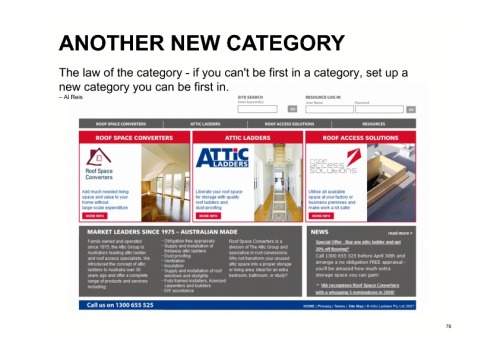
…and then you can focus some more!

by admin | Feb 17, 2011 | Blog, Strategy
Why are today’s smart marketers talking about Brand Promise rather than the all too familiar USP – Unique Selling Proposition?
The answer is simple. The low barriers to entry in most industries created by the free and almost instant flow of information, resulting in the hyper-competitive nature of today’s marketplace means there are very few unique products and services and if they are unique to begin with they do not stay so for very long.
This paradigm shift has repercussions for for every modern enterprise. It means that brand owners and marketers must create unique experiences for their customers and communicate them clearly to their prospects. Because these experiences are what will differentiate them from their competitors. To do so they must work out what it is that they can promise their customers.
Product, Price, and Place (distribution) can be easily copied by competitors, which is why marketers invest much time and budget into Promotion (Communication). What can not be copied is the relationship, the emotional connections you develop with your customers. And like all relationships, they require consistent and clear communication.
Brand Promise must be:
- A Benefit that is relevant and important to the target market.
- A benefit that is different from the competitors.
- A benefit that your company is able to deliver.
The benefit may be:
- Functional
- Emotional
- Experiential
- Self-Expressive
Brand Promise is ideally expressed as:
Only (name of your brand) delivers (relevant differentiated benefit) to (target customer).
The Brand Promise is a critical ingredient that assists marketers work out the Positioning Statement.


by admin | Feb 16, 2011 | Blog, Content, Promotion, Strategy

Cover via Amazon
People love stories from children’s fairy tales to books and movies. A story is more memorable than a straightforward message. A story is easy to re-tell and pass on to other consumers, hence providing your brand with more Word of Mouth Marketing opportunities.
A brand story needs to be:
- Real and authentic
- Colourful and interesting
Advertisements are nothing more than stories with the best ones engaging their audience. Famous brands such as Virgin and Apple have real stories surrounding their founders and form an important element of their positioning strategy.
Most common marketing stories:
Blake Snyder (professional screenwriter) has story scenarios that align to Maslow’s Hierarchy of needs:
- Physical Needs
- Safety Needs
- Social Needs (Buddy Love & Rights of Passage)
- Self Esteem Needs (Fool Triumphant & Superhero)
- Cognitive Needs (Everyman v Big Brother)
- Aesthetic Needs (Look good, Feel Good)
- Self Actualisation (Search for Meaning & Personal Salvation)
Gerald Zaltman, author of “How Customers Think” and Professor at Harvard Business School identifies deep metaphors in the minds of consumers in “Marketing Metaphoria”:
- Balance
- Transformation
- Journey
- Container
- Connection
- Resource
- Control
and Christopher Booker’s book, “Seven Basic Plots – Why We Tell Stories” (which took him 35 years to write) has the following:
- Overcoming the monster: Defeating a force which threatens safety, existence, success – David v Goliath
- The Quest: A group in search of something (who may find it or something ‘better’)
- Journey and Return: The hero journeys away from home and comes back (having experienced something and maybe having changed for the better)
- Comedy: Not necessarily ‘haha’ funny. a misunderstanding or ignorance is created that keeps parties apart, which is resolved, by the end, bringing them back together
- Tragedy: Someone, tempted (vanity, greed, etc), becomes increasingly desperate, or trapped by their actions, until the climax where they usually die
- Rebirth: Hero is captured or oppressed (a living death existence) until they are miraculously freed
- Rags to Riches: Overcoming a state of poverty, want, and/or need.
By telling your brand story you can differentiate your business and form a stronger connection with your customers and prospects. By understanding why you started the business, or for example why you named it in a certain way, customers will feel like they know you and understand you. After all it is hard to connect with someone you don’t understand.

by admin | Feb 13, 2011 | Blog, Strategy

Having a brand personality is important because brands are an emotional connection between your products and services and your target audience, and we now know that this emotional connection is critical in attracting and retaining customers.
Having a brand with a personality allows marketers to deliver communication that stands out from the “sameness” of their category and connect much faster and on a deeper level with prospects and customers. People can relate to things they feel have a personality, especially one which they can identify with. From the cars we drive to the pets we choose, we are subconsciously guided by our reflection in them.
Brand personality is usually a function of the following:
1. Personality and values of the founder
2. Personality and values of the current leader
3. Personality and values of the company’s most loyal customers.
Brand Personality is a critical input into the design of the overall brand, especially the:
– Brand Name,
– Brand Story, and
– Positioning Statement.
Brand Personality should flow right through the company and be positively reflected in the customer brand experience.
To work out your brand personality, you can engage the help of your best customers, colleagues, employees, suppliers and even friends, asking them to describe firstly your personality in 5-8 adjectives and then do the same for your company or organisation. In most cases you will find that they align. Alternatively there maybe a good reasons why you do not want them to align. What ever the outcome it will assist you greatly in projecting the right perceptions for you business to its target market.
The brand personality is the BRAND!
Here are a few famous examples: Virgin, Body Shop, Walmart, Oprah, Dr. Phil, Beckham Paul Newman’s Own, and most fashion designer label brands are all intrinsically linked to the personalities of the founders.
Although this has worked tremendously well for these and other businesses naming your brand new “baby” after yourself has many drawbacks, especially if you don’t have the name recognition of a super star athlete and in general naming the brand has a number of criteria that you need to consider a strategic process you should follow.
Here are a number of brand personality examples that have been created through focusing on a specific niche; great brand naming that reflects these personality traits:
– Geek Squad is both a consumer as well a USA SME technology company owned by the giant Best Buy retail group, assisting customers with everything from installing in home theatres to computer networking in their businesses. It’s great name and personality that permeates the company has now been copied in various formats all over the world yet none of the copycats can dream of the same success.
– Mr. Mutual Fund – Vern Hayden is one of the top financial planners in the USA specialising in mutual funds (superannuation). He got to be where he is by focusing and being the greatest expert on his area of expertise – mutual funds! However he chose a more traditional name for his company http://www.haydenwealth.com/ and decided not to link it directly to his personal brand of Mr. Mutual Fund.
– Ms. Megabyte and Gadget Guy are 2 independent Australian technology experts who entertain and inform Australians by providing reviews and demystifying technology. Everyone knows who they are, yet few would know of Yvonne Adele and Peter Blasina. This illustrates the power of correctly branding your business.
– Bounce Back Fast is a consultancy and training organisation that focuses on building resilience to pressure and stress.
– The Productivity Queen needs no explanation,
– Powerful Points is a leading Powerpoint training organisation that counts some of Australia’s top companies and their C-suite executives as it’s clients
When we look at most of the examples above, it quickly becomes apparent that these sometimes “one man bands” have a number of things in common:
1. They are specialists, they are “the only” in their market
2. They are easy to remember
3. They are easy to promote because they have a great name, a personality and a STORY to tell
4. They are famous amongst their intended target audience.
The next entry will cover the importance of telling your brand story!
 Image via Wikipedia
Image via Wikipedia

by admin | Feb 9, 2011 | Blog, Strategy

When examining examples of good and bad brand names we must use a set of reasonably objective evaluation criteria. As these were discussed in the last post, I will summarise all of them like this:
“It’s not what it is, but how you use it – your brand name that is!” This is especially true for small businesses that do not have multimillion dollar budgets to “make their brand synonymous” with a particular product or service through the sheer weight of their media investment.
Hence ‘campiagnability’, how the brand name provides the business with creative flexibility to promote it’s services and more memorably and emotionally connect with its customers is paramount.
Let’s look at a few examples:
Radio Rentals – the iconic Australian electronics retailer’s brand name may have been great when it was founded in the 1930’s in the UK, but today this functional or descriptive name is no longer relevant and is in fact very limiting. No brand consultant would ever recommend changing it unless there was a multimillion dollar budget and a great reason to do so, because the brand equity built over the years is too great but ‘radio rentals’ lost its relevance probably by the early 1950’s.
Most SME brands are today still named after their founders or are very descriptive in nature, a benefit when the business is starting out and the name tells the target audience exactly what the business is all about, e.g: John’s Plumbing Supplies, etc. However as the business grows the name doesn’t lend itself to be easily promoted…
The Shaver Shop franchise – a great concept – looks like it is facing a similar dilemma. What started as a focused category player is now selling a number of product categories that are no longer about shaving. Only time will tell if this “brand extension” will be successful. The brand name again was most likely too descriptive and limiting in the first place.
Let’s compare that with one of the world’s most famous and successful brands like Apple – which was never a name that sounded like it was in the computer business. Jobs came up with the name “Apple” after visiting an orchard and having a wonderful experience, an experience he wanted his customers to have with an approachable company, which the name Apple fit perfectly. Experiential names and names that tap into consumer emotions are more likely to become much greater assets. Branson did the same with Virgin in the music industry!
Here are some of the names we have developed for our clients:
D&M – A brand of natural skin care products
Fighting Fit For Life – A Personal Trainer that specialises in boxing and martial arts training
Room to Improve – For an interior designer and decorator
Money Rules – A debt reduction educational program and software
Sirius Business – A business coach
Meaningful Exchange – A multi-lingual translation service
Guys Domain – A psychotherapist specialising in men’s issues
Schoffered Tours – Personalised Wine Tour Operator
Everyone of these names creates a myriad of promotional possibilities for many years to come and this is further complimented by the brand positioning statements / slogans. You can see the names, logos and the positioning statements on the next post.
Finally a great name is worth protecting – ‘Trade Marking’. Do it through a professional IP lawyer, you may pay more but it is worth doing it correctly the first time around. There are a number of legal issues than can make the DIY approach more expensive in the long run.
For example in the Australian market place there are 2 “Women at Work” and 2 “The Extension Factory” businesses that obviously didn’t protect their great names when they started their business. If your name is worth using it is worth protecting.


by admin | Feb 4, 2011 | Blog, Strategy

Brand Names differentiate you from competitors, make an emotional connection with your audience, and help to build a brand that ignites the passions of your customers.
Yet most SME business owners are either frivolous about the naming of their business or alternatively spend countless days “brainstorming” without any direction or objective and have no method of evaluating their chosen short list of names.
Does your Brand Name:
- Achieve separation from your competitors?
- Demonstrate your difference?
- Reinforce a unique positioning platform?
- Create positive and lasting engagement with your audience?
- Make you unforgettable?
- Propel itself through the world on its own, becoming a no-cost, PR generating vehicle?
- Provide a deep well of marketing and advertising images?
- Have the potential to dominate a category?
Igor International is a specialist naming agency in San Francisco that has developed a comprehensive brand naming guide – which just illustrates the power of specialisation and focus!
Their naming guide is essential reading for any entrepreneur or SME Marketer, or in fact any marketer facing the task of developing this critical business asset. The guide provides a number of evaluation criteria that will help evaluate your short list of names. From how memorable the name is to how it sounds and looks, how it works in positioning your company and to how appropriate it is in actually conveying your business benefits.
Here we will summarise their process, which is almost identical to the overall brand development, including brand Positioning and Positioning Statement (Slogan):
1. Competitive Analysis
Make sure your chosen name is significantly different to the way others in your category name their business. Most SME’s in the services category still use the naming convention that is as old as business itself…their own name! Just look at any of the service categories and you’ll find accountants and architects through to engineers and lawyers and most consulting companies still using this outdated principle that misses out on all of the opportunities we described earlier to propel your business into the spotlight!
2. Positioning
The more focused your positioning is, the more effective the name will be. All great product and company names work in concert with the positioning of the businesses they speak for.
3. Name/Brand Development
Use positioning strategy to figure out what you want your new name to do for your communication efforts.
4. Trademark / Domain Name
Determine the likelihood that your company will be able to secure the name and a website domain, which is now one of the toughest tasks with so many names and even 2 to 3 word expressions being registered by domain name squatters!
5. Creative/Testing
Produce creative materials to test leading name candidates.
6. Name and Tagline
Final names and taglines, along with a well-defined positioning strategy, are the outcome of the process.
In the next entry we will examine some examples of good and bad brand names.
 Image via Wikipedia
Image via Wikipedia





















Recent Comments